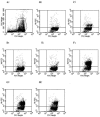Evaluation of various methods of maternal placental blood collection for immunology studies
- PMID: 16682478
- PMCID: PMC1459646
- DOI: 10.1128/CVI.13.5.568-574.2006
Evaluation of various methods of maternal placental blood collection for immunology studies
Abstract
The collection of maternal placental intervillous blood (IVB), without contamination of fetal blood and with an accurate mononuclear cell profile, is essential for immunological studies of placental malaria and other infectious diseases of the placenta. We have compared five documented methods of IVB collection: perfusion, incision, biopsy, tissue grinding, and puncture (prick) for fetal blood contamination and mononuclear cell profiles using flow cytometry. Twenty-five placentas were obtained from Plasmodium falciparum and human immunodeficiency virus-negative primigravid and secundigravid women delivering at Nyanza Provincial Hospital in Kisumu, western Kenya. Each of the five methods was performed on the same placenta. Fetal red blood cell contamination was significantly lower for the prick and perfusion methods (4.1% and 8.3%, respectively) than for incision (59.5%), biopsy (42.6%), and tissue grinding (19.9%). Significant variation was noted among the five methods in the percentages of monocytes, total T cells, CD4+ and CD8+ T cells, B cells, and NK cells. Further, a pairwise comparison of prick and perfusion, the two methods with low fetal blood contamination, showed that they were not different for fetal red blood cell contamination levels; however, prick yielded significantly higher percentages of CD4 T cells and CD4 memory T cells than perfusion. Collection by prick was determined to be the best method of intervillous blood collection for immunology studies, and perfusion represented the next best method of choice due to high sample volume yield. Overall, in considering the advantages/disadvantages of the two methods with low fetal cell contamination, we conclude that a combination of prick and perfusion is most suitable for immunology studies.
Figures



References
-
- Abbasi, M., K. Kowalewska-Grochowska, M. A. Bahar, R. T. Kilani, B. Winkler-Lowen, and L. J. Guilbert. 2003. Infection of placental trophoblasts by Toxoplasma gondii. J. Infect. Dis. 188:608-616. - PubMed
-
- Barragan, A., and L. D. Sibley. 2003. Migration of Toxoplasma gondii across biological barriers. Trends Microbiol. 11:426-430. - PubMed
-
- Bulmer, J. N., F. N. Rasheed, N. Francis, L. Morrison, and B. M. Greenwood. 1993. Placental malaria. I. Pathological classification. Histopathology 22:211-218. - PubMed
-
- Camelo, J. S. J., F. E. Martinez, S. M. Jorge, and M. Matheus de la Sala. 1995. A new method for sampling maternal blood in the intervillous space. Fetal Diagn. Ther. 10:322-325. - PubMed
-
- Crocker, I. P., O. M. Tanner, J. E. Myers, J. N. Bulmer, G. Walraven, and P. N. Baker. 2004. Syncytiotrophoblast degradation and the pathophysiology of the malaria-infected placenta. Placenta 25:273-282. - PubMed
Publication types
MeSH terms
Substances
Grants and funding
LinkOut - more resources
Full Text Sources
Medical
Research Materials

